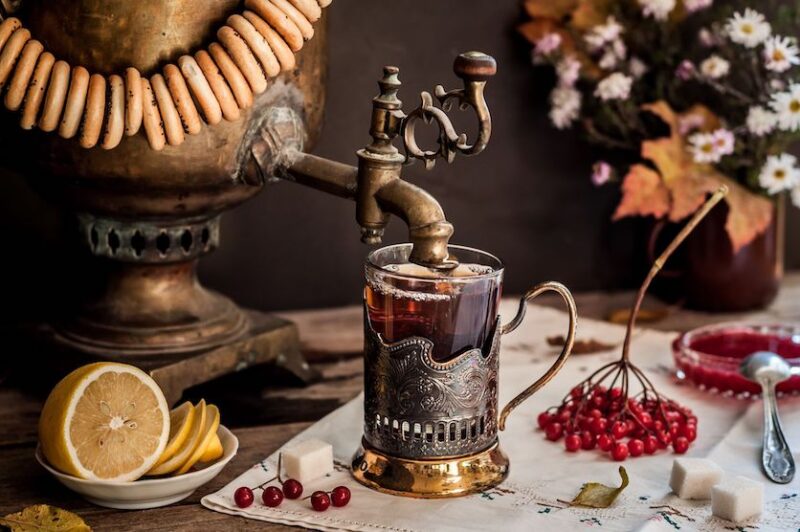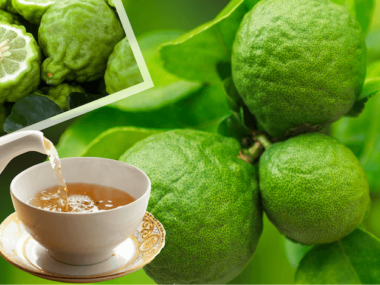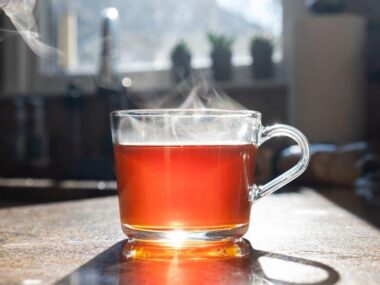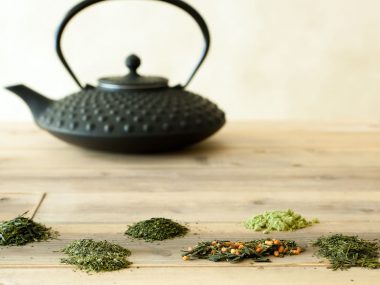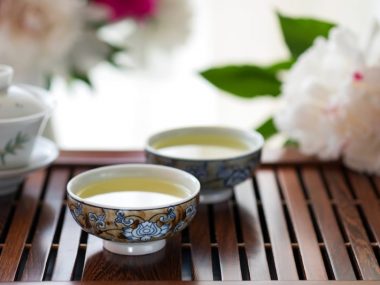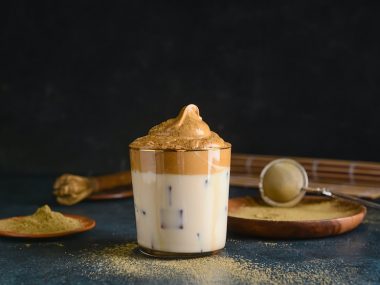We bet you have had this tea before. However, you have probably enjoyed it all wrong. What makes Russian tea unique is how it’s prepared and served. The vessel used for this tea used to grace almost every home in 19th century Russia, so the odds are you’ve never even heard of it before!
Table of Contents
What is Russian Tea Made Of?
The ingredients of a typical traditional Russian tea include any type of black tea, lemon, and sugar. Russian Caravan tea and Russian spiced tea are two other tea varieties many Russians enjoy.
Russian Caravan tea is a particularly interesting tea because of its smokey nuances from being smoked over a bed of pine wood. This tea is a base of black, black blends, or oolong. Originally this tea got its name from a caravan of traders who traveled from China to Russia carrying the much-awaited tea for the Tsar back in the 18th century.
As the caravan stopped to rest, the nearby campfire smoke wafted over the tea cargo. Once the tea arrived in Russia, the tea was found to have a smoky aroma and flavor. The Russians loved this flavor so much that the tea began to be roasted over beds of pine from thereafter.
Russian Spiced tea, on the other hand, is a favorite during the cold months because of the spices added to a black tea. Black tea is infused with cinnamon, orange peel, and clover. The flavor of Russian tea ranges from sweet, smokey, and citrusy. If the tea has been cultivated in the south of Russia, it takes on a different flavor profile that includes more floral, fruity, caramel notes.
Russian Tea Culture
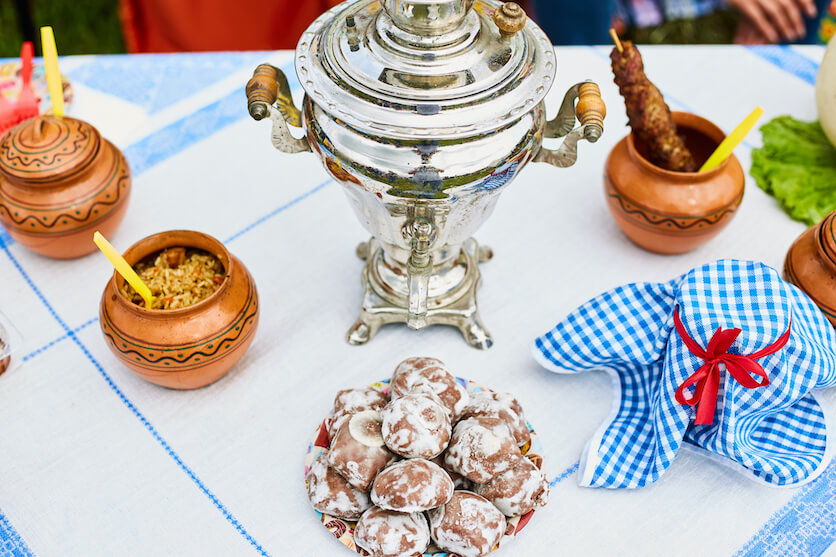
Russians are similar to the English, who have strong traditions surrounding English Breakfast tea and afternoon tea ceremonies. In Russia, loose leaf tea is preferred over tea bags. Black tea is the most common tea consumed in Russia.
Russians drink tea in a similar manner to Britons. It’s unequivocally an intentional time to fellowship with others or to experience a few moments of peace. Unlike those of us here in the U.S. Americans are more prone to grab a quick cup of coffee or tea while on the go. Other countries truly appreciate a purposeful “downtime” to savor a cup of tea. Tradition is what it’s all about.
A longstanding tradition behind how the Russians prepare, serve, and drink tea is very different than what we may be accustomed to. Their tea culture began as a result of a gift of tea to a Russian Tsar back in the mid-1600s. Once tea caught on, it has continued to be a beverage of choice in Russia.
The History Of Russian Tea
A ruler of the Mongol Empire gifted tea to the Russian Tsar back in the mid-1600s. At this time, tea wasn’t something the Russians were familiar with. Envoys of the Khan carried what was claimed to be 200 blocks/packs of loose leaf tea and presented the tea to the court in Moscow where the Tsar ruled.
Up until this gift of tea, the only beverage consumed by nobility in Russia was “Sbiten.” This oddly-named drink was made with hot water, herbs, and honey. Tea quickly replaced Sbiten as the top beverage of choice.
During the late 1700s, importations of about one million pounds of tea came into Russia of which the upper crust society members purchased and consumed. Tea was such as exotic delicacy that an upper-class family was limited to one pound per person per year. At the time, people paid an exorbitant amount causing them to limit the use of their tea for therapeutic purposes only.
The high dollar constraints on tea began to loosen, making tea a bit more easily attainable by the 1800s. However, it was a long time before the middle to lower class were able to afford it. Once they did, tea became a staple in almost every home in Russia.
The Samovar — a Staple of the Russian Tea Culture
As tea peaked with society, so too did the very element that became the center of Russian tea culture, which was the “samovar.” A samovar is a large urn-like pot with a wide belly and spigot. This giant teapot-like object was designed to hold a day’s worth of tea warm which helped people get through the long winter days of bone-chilling cold.
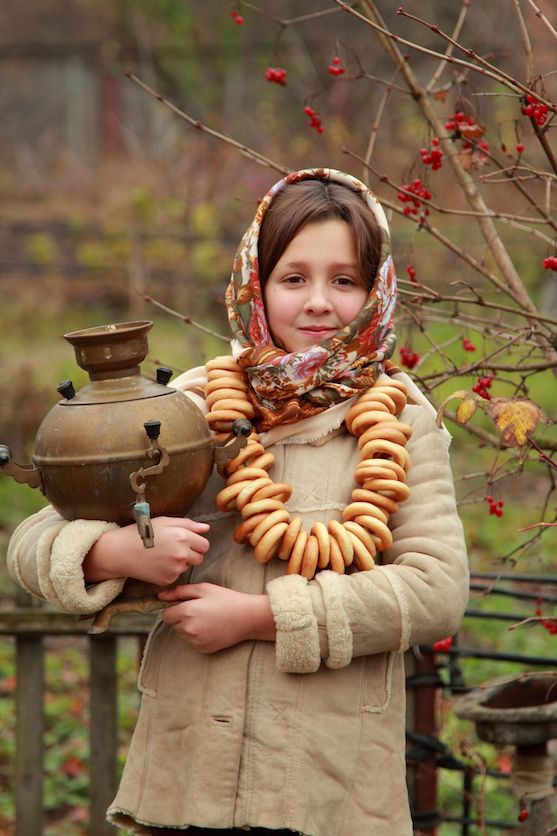
Samovars of the 18th century were typically made from copper, silver, iron, or Tula steel. It’s rare to find a traditional samovar that has the pipe and hot coal feature. Now you’ll find them with electrical components built in to heat the water. Dual samovars have the capability to serve coffee and tea. Samovars may be more modern in design, but the ornate beauty can still be incorporated into hand-made, high-end models.
Ironically, the samovar is symbolic of Russian culture, but it did not originate in Russia. The first samovar was discovered 3,600 years ago in Azerbaijan.
Historial samovars were made of gold or silver and flaunted precious gems encrusted on the exterior. Tea time was ceremonial because of the samovar. The traditional samovar featured a large pipe in the center of the body. Slow-burning coals were placed inside (at the bottom) of this pipe. The pipe acted as a flue in which the heat moved upwards where a teapot sat. Surrounding the pipe was the bowl of the samovar which held the water. This water was heated from the hot pipe.
The teapot sitting on top of the pipe contained a dense concentration of tea (1 part water, 10 parts tea) which was kept warm. Drinkers would partially fill tea glasses with hot water from the samovar’s spigot and then add some of the concentrated tea from the teapot. Lemons and cubes of sugar were added to the tea glass.
Tea Glasses
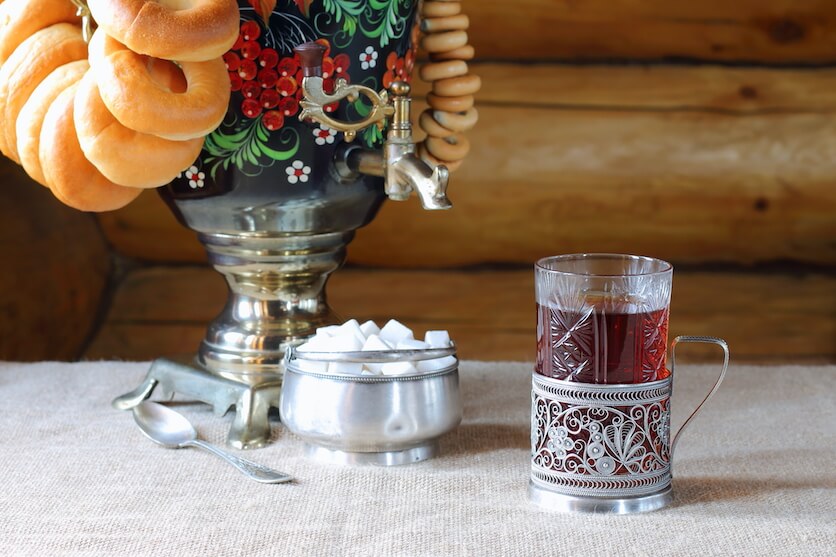
Russian tea glasses are just as beautiful as the samovar, also lending a certain royal ambiance to tea time. Small glasses rested in ornate metal holders with handles. The tea was so hot that the handled holders had to be used.
To add more wow factor to tea time, Russians hung a string of pastries on the samovar. These pastries were kept nice and warm from the heat of the samovar. “Baranki” and “Sushkas” are pastries that look like a cross between a small bagel and a donut. Baranki is more along the line of a bagel because the dough is boiled.
Why Is Russian Tea Called “Russian Tea?”
To the dismay of many, Russian tea is not Russian at all. It is tea made from black tea sourced from another country such as China or India. The way the tea is enjoyed is what lends to its name. Russians enjoy their tea with lemon and sugar hence “Russian tea.”
Is It Okay To Drink Russian Tea Every Day?
Drinking black tea daily is beneficial provided it’s within the recommended daily intake of caffeine (maximum of 400 mg a day.) There’s also the added benefit of Vitamin C obtained from lemon in the tea. As for daily intake of sugar, moderation is the key, especially if you enjoy tea with sugar. The citric acid in lemons may erode teeth enamel if consumed in large quantities.
A six-ounce cup of black tea contains up to 50 mg of caffeine. So, you would be able to enjoy about eight cups of tea a day. Keep in mind that caffeinated tea enjoyed after 3:00 pm may affect your sleep.
Russian Tea Benefits
Because black tea is typically the base of Russian tea, there’s a powerhouse of benefits from enjoying this tea. First of all, you gain from the benefits of polyphenols, catechins, and flavonoids in the tea that help prevent and protect against chronic conditions. Secondly, you gain from having lemon in the tea, which provides you Vitamin C.
Improves Diabetes and Encourages Weight Loss
Polyphenols which are present in the tea, tells our body to activate AMPK (an enzyme), which encourages control of glucose and how our body stores fat. This is highly beneficial for those of us with diabetes or looking to lose weight. One of the known weight loss tools is drinking lemon water. Lemon water not only keeps us satiated but also burns fat. Russian tea gives you a double bonus when it comes to weight loss benefits!
Promotes Heart Health
Researchers found Russian tea (black tea) to be highly beneficial in preventing disorders of the heart. Black tea reduces cholesterol (which is a leading risk factor in heart disease.) Those at risk of cholesterol-related heart conditions see improvement by drinking the tea. Obesity is another risk factor that leads to heart disorders. Black tea aids in weight loss which in turn significantly improves and prevents heart attack, stroke, high blood pressure, etc.
How Do You Make Russian Tea?
Contrary to what some may think, Russian tea is quite easy to make. The ingredients and brewing are fairly straightforward.
Traditional Russian Tea Recipe
Most of us don’t have a samovar resting on our kitchen counter, so we will brew the following recipes conventionally.
Ingredients
- 1 teaspoon of loose-leaf black tea (or 1 teabag)
- 1 slice of lemon
- 1 cube of sugar (or ⅛ teaspoon of honey)
- 2 cups of water
Directions
- Bring the water to a boil.
- Remove from heat.
- Place loose leaf tea in an infuser and drop it into the hot water (or use a teabag.)
- Allow to steep for 5 minutes.
- Remove the infuser (or tea bag.)
- Pour the tea into a teacup.
- Add sugar and a slice of lemon.
- Enjoy!
Tip: If you don’t have a fresh lemon for your tea, you can use ¼ teaspoon of lemon juice.
Russian Caravan Tea Recipe
We’ve combined two styles of Russian tea into one to give you the best of both worlds in one teacup!
Ingredients
- 2 cups of water
- ½ teaspoon of loose leaf Lapsang souchong tea
- ½ teaspoon of loose leaf Keemun tea
- ½ teaspoon of oolong tea
Tip: Blend your loose leaf teas together before adding them to an infuser.
Directions
- Bring the water to a boil.
- Remove from heat.
- Place loose leaf tea in an infuser and drop it into water.
- Allow to steep for 5 minutes.
- Pour into a teacup.
Russian Tea Is A “Noble” Thing
Russian tea prepared and served in a samovar will make any tea drinker feel like royalty. The ceremonialism behind such a simple tea we’ve all most likely enjoyed (tea and lemon) is elevated by the mere vessel it’s brewed upon. We don’t know about you, but the whole experience is well worth enjoying!
